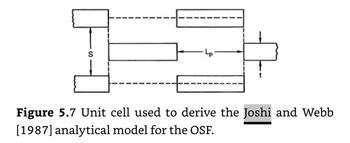
Elements Of Electromagnetics
7th Edition
ISBN: 9780190698614
Author: Sadiku, Matthew N. O.
Publisher: Oxford University Press
expand_more
expand_more
format_list_bulleted
Concept explainers
Question

Transcribed Image Text:### Figure 5.7: Unit Cell for Derived Analytical Model
The figure illustrates a unit cell that is utilized in deriving the analytical model by Joshi and Webb (1987) for the OSF (Orthogonally Stiffened Frame).
#### Explanation:
- **Unit Cell Structure:** The diagram shows a simplified representation of a unit cell.
- **Arrows and Lines:**
- Several arrows indicate forces or directions of stress/strain within the structure.
- "S" denotes a specific parameter associated with the unit cell's structure.
- "Lp" represents another parameter, possibly related to the length or another geometric aspect of the unit cell.
### Detailed Description:
- The unit cell consists of rectangular blocks with arrows suggesting the directions of forces or connections within the framework.
- The outer rectangles are connected with dashed lines, likely indicating the boundary or the limits of the unit cell.
- The parameter "S" and "Lp" are key variables in the model being derived.
**Purpose:** This visual representation helps in understanding how the analytical model quantifies the behavior of the OSF by breaking it down into manageable units.
**Reference:** Derived from the work of Joshi and Webb from their 1987 analytical model, the unit cell serves as a foundational element for studying and modeling structural behaviors in orthogonally stiffened frames.
For more in-depth learning, refer to Joshi and Webb's original studies and subsequent elaborative content on analytical models for architectural and engineering frameworks.

Transcribed Image Text:### Application of Analytical Model for Heat Transfer and Friction Characteristics in OSF Arrays
#### Overview
We aim to implement the analytical model developed by Joshi and Webb to predict the heat transfer and friction characteristics (denoted as **j** and **f**, respectively) of the Offset Strip-Fin (OSF) array.
#### Table 1: Surface Characteristics Data
The following table provides key parameters for two specific surface types used in the study.
| **Surface** | **α** | **t/l** | **h (mm)** | **t (mm)** | **D_h (mm)** | **f** |
|-------------|----------|---------|------------|------------|--------------|-----------|
| 1 | 0.123 | 0.016 | 38.1 | 0.406 | 7.518 | 0.0551 |
| 8 | 0.224 | 0.064 | 38.1 | 1.626 | 10.897 | 0.0434 |
#### Instructions
1. **Plotting Nu vs fin length (l):**
Use the Webb and Joshi model as specified in the course notes to create a plot of Nusselt number (Nu) versus the fin length (l) in the range of 1 mm to 5 mm, in 0.5 mm increments or smaller. For these calculations, utilize the following parameters:
- α = 0.184
- t = 0.102 mm
- h = 4.98 mm
- \(Re_{D_h}\) = 500
While plotting, explain the behavior of the Nusselt number (Nu) in relation to different lengths (l). Assume the fin efficiency to be 1.
2. **Conversion to j-factors:**
Convert the Nusselt number data from Problem 2 into j-factors, assuming \(Pr = 0.7\). Next, calculate the friction factor for the same values of fin length (l), \(Re_{D_h}\), and the geometric parameters. Plot the ratio \(f/j\) versus the fin length (l) for the range 1 mm < l < 5 mm. Evaluate the plot to verify the Reynolds analogy and discuss why the observed trends should be expected.
### Detailed Graphs and
Expert Solution
This question has been solved!
Explore an expertly crafted, step-by-step solution for a thorough understanding of key concepts.
Step by stepSolved in 3 steps with 6 images

Knowledge Booster
Learn more about
Need a deep-dive on the concept behind this application? Look no further. Learn more about this topic, mechanical-engineering and related others by exploring similar questions and additional content below.Similar questions
Recommended textbooks for you
 Elements Of ElectromagneticsMechanical EngineeringISBN:9780190698614Author:Sadiku, Matthew N. O.Publisher:Oxford University Press
Elements Of ElectromagneticsMechanical EngineeringISBN:9780190698614Author:Sadiku, Matthew N. O.Publisher:Oxford University Press Mechanics of Materials (10th Edition)Mechanical EngineeringISBN:9780134319650Author:Russell C. HibbelerPublisher:PEARSON
Mechanics of Materials (10th Edition)Mechanical EngineeringISBN:9780134319650Author:Russell C. HibbelerPublisher:PEARSON Thermodynamics: An Engineering ApproachMechanical EngineeringISBN:9781259822674Author:Yunus A. Cengel Dr., Michael A. BolesPublisher:McGraw-Hill Education
Thermodynamics: An Engineering ApproachMechanical EngineeringISBN:9781259822674Author:Yunus A. Cengel Dr., Michael A. BolesPublisher:McGraw-Hill Education Control Systems EngineeringMechanical EngineeringISBN:9781118170519Author:Norman S. NisePublisher:WILEY
Control Systems EngineeringMechanical EngineeringISBN:9781118170519Author:Norman S. NisePublisher:WILEY Mechanics of Materials (MindTap Course List)Mechanical EngineeringISBN:9781337093347Author:Barry J. Goodno, James M. GerePublisher:Cengage Learning
Mechanics of Materials (MindTap Course List)Mechanical EngineeringISBN:9781337093347Author:Barry J. Goodno, James M. GerePublisher:Cengage Learning Engineering Mechanics: StaticsMechanical EngineeringISBN:9781118807330Author:James L. Meriam, L. G. Kraige, J. N. BoltonPublisher:WILEY
Engineering Mechanics: StaticsMechanical EngineeringISBN:9781118807330Author:James L. Meriam, L. G. Kraige, J. N. BoltonPublisher:WILEY

Elements Of Electromagnetics
Mechanical Engineering
ISBN:9780190698614
Author:Sadiku, Matthew N. O.
Publisher:Oxford University Press

Mechanics of Materials (10th Edition)
Mechanical Engineering
ISBN:9780134319650
Author:Russell C. Hibbeler
Publisher:PEARSON

Thermodynamics: An Engineering Approach
Mechanical Engineering
ISBN:9781259822674
Author:Yunus A. Cengel Dr., Michael A. Boles
Publisher:McGraw-Hill Education

Control Systems Engineering
Mechanical Engineering
ISBN:9781118170519
Author:Norman S. Nise
Publisher:WILEY

Mechanics of Materials (MindTap Course List)
Mechanical Engineering
ISBN:9781337093347
Author:Barry J. Goodno, James M. Gere
Publisher:Cengage Learning

Engineering Mechanics: Statics
Mechanical Engineering
ISBN:9781118807330
Author:James L. Meriam, L. G. Kraige, J. N. Bolton
Publisher:WILEY